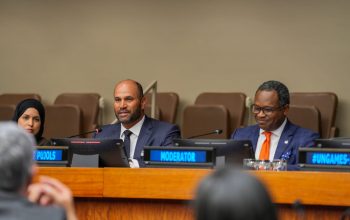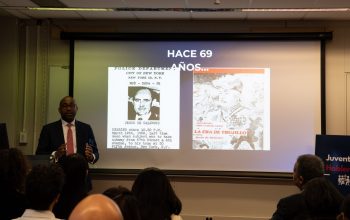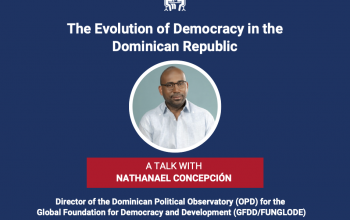news
“Dominicans in the U.S.,” an article by Dr. Leonel Fernández
January 5, 2016
It’s estimated that there are currently 1.8 million people of Dominican origin residing in the United States, according to an analysis from the Pew Research Center, a social research fact tank.
This analysis considers Dominicans to be those born in the Dominican Republic and classed as immigrants in the United States, or those born on U.S. soil to parents of Dominican origin.
Dominicans constitute the fifth-largest population
of Hispanic origin in residence in the United States, after Mexicans, Puerto Ricans, Cubans, and Salvadorans. Since 1990, the Dominican-origin population has grown by more than 300 percent, from 517,000 people to its current level of 1.8 million.
In 1990, for example, the number of immigrant Dominicans in the United States stood at 382,977 people. A decade later, it had risen some 86 percent to reach 710,200. By 2013 that number saw further growth of 85 percent to top
982,000 inhabitants.
In the case of nationals born in the United States to Dominican parents, the increase has been spectacular. The last 25 years have seen even more intense and accelerated growth among this population than among immigrants, in a trend that has been accompanied by the development of a new profile for Dominicans in the United States.
In 1990, the number of children born to Dominican parents on U.S. soil was just 203,723. By 2000 this
figure stood at 400,221, for an increase of 97 percent. The remarkable thing about this phenomenon, however, is that by 2013 that number had more than doubled again, to include nearly 900,000 people.
All this means that of the 1.8 million Dominicans currently resident in the United States, nearly half are immigrants, and the other half are U.S.-born children of Dominicans, with the latter group projected to soon outnumber the former.
Dominican migration
Dominican migration to the United States has occurred over various historical moments or epochs, beginning in the 16th century.
In fact, migrants have been departing since that now-distant epoch from the Captaincy General in Santo Domingo en route to New Spain, composed of territories such as the modern Florida and Louisiana.
The first person to migrate outside New Spain from what would later
become the Dominican Republic to what would eventually become the United States was a merchant marine named Juan Rodríguez.
Rodríguez is said to have arrived to the island of Manhattan some 400 years ago, in 1613, from his place of origin in Santo Domingo, becoming not just the first Dominican but the first Latino to take up residence in what is today part of New York City.
Dominican migration to the United States would continue over the coming
centuries.
According to a study done by Dr. Ramona Hernández, Director of CUNY’s Institute for Dominican Studies, one such wave of Dominican migration to the United States has been forgotten.
This migration took place between 1892 and 1924, when more than 5,000 Dominicans entered U.S. territory through Ellis Island, home to the Statue of Liberty, in a historical moment dominated by European immigration.
Nonetheless, it was
only during the 60s, after the death of the dictator Rafael Leónidas Trujillo, when massive flows of Dominicans began to leave for the United States. This trend intensified after the April Revolution of 1965 and later in the 90s, with the arrival of half of those now resident in U.S. territory as a consequence of the economic crisis of the late 80s and the pessimism over the Dominican Republic’s future following the 1990 elections.
In geographical terms, the
highest concentration of Dominicans in the United States is found in five Eastern coastal states: New York, with nearly 700,000 residents; New Jersey, with more than 200,000; Florida, with more than 180,000; Massachusetts, with nearly 110,000; and Pennsylvania, with around 65,000. In Manhattan, New York City, Dominicans constitute the most numerous group of Hispanics, with the Washington Heights neighborhood considered the heart of the Dominican community in the United States.
To recognize this, the Broadway musical In The Heights was produced, written by Puerto Rican playwright Lin-Manuel Miranda, winner of both a Tony and a Grammy Award.
Of course, many Dominicans also live in other areas of New York besides Manhattan, especially in the Bronx and to a lesser extent in Queens, Brooklyn, and Long Island. In New Jersey, Dominicans are concentrated in Paterson, Jersey City, Passaic, Newark, and Perth Amboy.
There are many Dominicans in the cities of Boston, Lawrence, Providence, Miami, Orlando, Tampa, and Philadelphia. Likewise, Dominican populations have begun to grow in the states of Maryland, Georgia, North Carolina, Virginia, Ohio, Texas, and California.
Socioeconomic profile
Perhaps the greatest contribution made by U.S.-resident Dominicans to their country of origin, the Dominican Republic, is the sending of remittances, that is,
money to family, friends, and relatives.
These remittances began to flow gradually starting in the 70s, and according to data from the World Bank, by 2012 the Dominican Republic was receiving some $3.6 billion from Dominicans abroad, equivalent to 6.9 percent of the country’s gross domestic product (GDP).
This sum represents the third most important source in the Dominican economy for the generation of foreign currency, after the export
sector, at 15.2 percent of GDP, and tourism, at 7.9 percent.
Surprisingly, remittances provide a greater source of revenue capture than foreign direct investment, which for the same period stood at $3.1 billion, or 5.3 percent of GDP.
Despite their significant contribution to the national economy, the situation of Dominicans in the United States is not particularly favorable. Average annual income among Dominicans aged 16+ is just $20,000. This is lower
than that of other Hispanic groups in the country, and obviously also that of the U.S. population overall, among whom that figure is $30,000.
The proportion of Dominicans living beneath the poverty line is 28 percent, much higher than the U.S. population overall, at 16 percent. Those who have their own homes make up just 24 percent, compared to other Hispanic groups, at 45 percent, and the overall population, at 64 percent.
Just 10 percent of adult
Dominicans speak English fluently. But among the group of immigrants, that figure is even worse—just 3 percent. This is beneath the average for other Hispanic groups, at 25 percent.
But if this situation is rather bleak among adults, among young people it is reversed. A majority of 57 percent of Dominicans aged 5+ have full command of English. Some 17 percent of those over 25 have obtained a university degree. Among that group, those born in the United States are more
inclined to obtain a degree than immigrants.
All this information makes clear how the Dominican presence in the United States has evolved in recent times. From a poor and marginalized community it has increasingly developed into a young, bilingual, bicultural community with better academic preparation and a greater tendency toward integration with U.S. society overall.
All this obligates us, with an eye to the future, to rethink and redefine the
relationship between the Dominican Republic and our compatriots of the Diaspora, and form a strategic alliance founded on the values of patriotism, solidarity, and development based on mutual benefit.
Related links:
http://leonelfernandez.com/articulos/los-dominicanos-en-ee-uu/
http://www.listindiario.com/la-republica/2016/01/05/402696/los-dominicanos-en-eeuu






